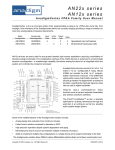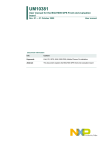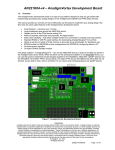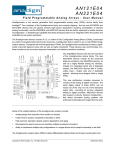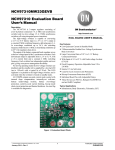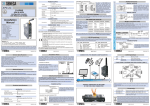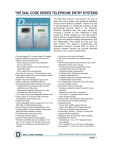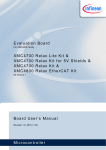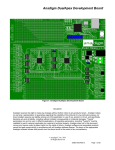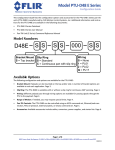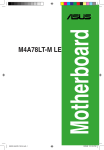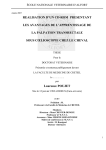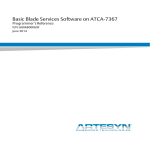Download AN131/231E04 User Manual..
Transcript
AN13x series AN23x series AnadigmApex dpASP Family User Manual AnadigmApex represents the third generation of dynamically programmable Analog Signal Processor (dpASP) devices from Anadigm. Two members of the AnadigmApex family are currently shipping providing access to the latest in programmable analog technology: AN131E04 and AN231E04. Both of these devices provide 7 analog I/O Cells and 4 Configurable Analog Blocks (CABs). IO Cell 7 (Type 2a) Chopper Amplifier Support IO Cell 6 (Type 2) IO Cell 5 (Type 2) SCLK ACLK IO5N IO5P IO6N IO6P IO7N IO7P This third generation dpASP delivers improved analog performance and increased value. The configuration interface of the AN23x devices is enhanced to accommodate dynamic reconfiguration - a breakthrough capability that allows analog circuit functionality to be controlled by a companion host processor. Clock Generation Bi-Directional Switch Fabric Connects any CAB to any Input / Output Cell Analog MODE Logic 0 1 2 3 4 5 I2N O2P IO Cell 2 (Type 1) I2P O2N O1P IO Cell 1 (Type 1) I1P I1N CAB3 CAB4 Configuration RAM Shadow RAM CAB2 CS1b CS2b Configuration Interface O3N CAB1 Configuration RAM Shadow RAM O3P IO Cell 3 (Type 1a) I3P I3N Shadow RAM Configuration RAM O4N Shadow RAM Configuration RAM O4P Bi-Directional Switch Fabric Connects any CAB to any Input / Output Cell I4N IO Cell 4 (Type 1a) I4P SI CFGFLGb ACTIVATE ERRb RESETb SO MEMCLK LCCb O1N VREF+ VMR VREF- Look-Up Table BVSS VREFN VMR VREFP Voltage Refrences BVDD DVSS AVSS DVDD AVDD Power & Gnd • Faster time-to-solution compared to discretes or ASICs • High precision operation despite system degradation and aging • Eliminates the need to source and maintain multiple inventories of product • Ability to implement multiple chip configurations in a single device and to adapt functionality in the field The Anadigmvortex solution allows OEMs to deliver differentiated solutions faster and at lower overall system cost. Copyright © 2006 Anadigm, Inc., All Rights Reserved UM000231-U001e Legal Notice Anadigm reserves the right to make any changes without further notice to any products herein. Anadigm makes no warranty, representation or guarantee regarding the suitability of its products for any particular purpose, nor does Anadigm assume any liability arising out of the application or use of any product or circuit, and specifically disclaims any and all liability, including without limitation consequential or incidental damages. "Typical" parameters can and do vary in different applications. All operating parameters, including "Typicals" must be validated for each customer application by customer's technical experts. Anadigm does not in this manual convey any license under its patent rights nor the rights of others. Anadigm software and associated products cannot be used except strictly in accordance with an Anadigm software license. The terms of the appropriate Anadigm software license shall prevail over the above terms to the extent of any inconsistency. Copyright © 2005 Anadigm, Inc. All Rights Reserved Anadigm, and AnadigmDesigner, are registered trademarks of Anadigm, Inc. The Anadigm logo is a trademark of Anadigm, Inc. Copyright © 2006 Anadigm, Inc., All Rights Reserved UM000231-U001e Ta b l e o f C o n t e n t s 1 Architecture Overview 1 Using a dynamically programmable Analog Signal Processor ..................................................... 2 2 Typical Configuration Interface Connections 3 2.1 Dynamic Operation ............................................................................................................................... 3 2.2 Static Operation .................................................................................................................................... 4 Pull-Ups on SI .............................................................................................................................. 6 Pull-Ups on ERRb ........................................................................................................................ 6 Pull-Ups on ACTIVATE ................................................................................................................ 6 Pull-Ups on CFGFLGb ................................................................................................................. 6 3 Analog Architecture Details 7 3.1 Types 1 and 1a IO Cells ....................................................................................................................... 7 Bypass.......................................................................................................................................... 7 Digital ........................................................................................................................................... 7 Analog Input ................................................................................................................................. 7 Analog Output .............................................................................................................................. 8 VMR Output.................................................................................................................................. 8 Amplifier Detail - Rauch Filter Designs......................................................................................... 8 3.2 Types 2 and 2a IO Cells ....................................................................................................................... 9 Digital Input .................................................................................................................................. 9 Digital Output................................................................................................................................ 9 Analog Input ................................................................................................................................. 9 3.3 CAB ....................................................................................................................................................... 9 4 Configuration Interface Details 10 4.1 Pin Descriptions .................................................................................................................................. 10 MODE......................................................................................................................................... 10 SCLK (Serial Clock) ................................................................................................................... 10 MEMCLK (Memory Clock).......................................................................................................... 10 ACLK (Analog Clock) ................................................................................................................. 10 SI (Serial In) ............................................................................................................................... 10 SO (Serial Out) ........................................................................................................................... 10 LCCb (Local Configuration Complete) ....................................................................................... 10 CS1b (Chip Select 1).................................................................................................................. 10 CS2b (Chip Select 2).................................................................................................................. 10 CFGFLGb (Configuration Flag) .................................................................................................. 11 ERRb (Error) .............................................................................................................................. 11 ACTIVATE .................................................................................................................................. 11 RESETb ..................................................................................................................................... 11 4.1.1 Secondary Pin Functions ............................................................................................................... 11 4.2 Special Functions - Configuration and Control Features .................................................................... 12 4.2.1 Resets ............................................................................................................................................ 12 4.2.2 ERRb .............................................................................................................................................. 12 4.2.3 Watchdog ....................................................................................................................................... 12 4.2.4 Analog and Configuration Clock Generation .................................................................................. 13 4.3 SRAM .................................................................................................................................................. 14 4.3.1 LUT................................................................................................................................................. 14 4.3.2 Auxiliary Cell (AN23x Only) ............................................................................................................ 14 Immediate................................................................................................................................... 14 Event Driven ............................................................................................................................... 14 Event Driven and Armed ............................................................................................................ 14 Clock Synchronization ................................................................................................................ 14 Copyright © 2006 Anadigm, Inc., All Rights Reserved i UM000231-U001e Ta b l e o f C o n t e n t s 5 Dynamic Operation Details 15 5.1 Configuration Data Stream Protocol ................................................................................................... 15 5.1.1 Primary Configuration Format ........................................................................................................ 15 5.1.2 Header Block .................................................................................................................................. 17 SYNC BYTE ............................................................................................................................... 17 Device ID BYTE ......................................................................................................................... 17 ADDR1 BYTE ............................................................................................................................. 17 5.1.3 Data Block ...................................................................................................................................... 18 CONTROL BYTE ....................................................................................................................... 18 Write ........................................................................................................................................... 18 RESET_ALL ............................................................................................................................... 18 ENDEXECUTE ........................................................................................................................... 18 BYTE ADDRESS BYTE ............................................................................................................. 19 BANK ADDRESS BYTE ............................................................................................................. 19 DATA COUNT BYTE.................................................................................................................. 20 DATA BYTE ............................................................................................................................... 20 DATA BLOCK END BYTE.......................................................................................................... 20 CRC_MSB and CRC_LSB BYTEs ............................................................................................. 20 5.1.4 Update Format (AN23x Only) ......................................................................................................... 21 5.2 Configuration Examples ...................................................................................................................... 22 Primary Configuration Format Example ..................................................................................... 22 Update Format Example (AN23x Only) ...................................................................................... 23 5.3 Advanced Feature - Logical Addressing ............................................................................................. 23 Tieing CFGFLGb Pins Together in multi-dpASP Systems ......................................................... 24 6 Package and Pin Information 25 6.1 Recommended PCB Design Practices ............................................................................................... 27 Copyright © 2006 Anadigm, Inc., All Rights Reserved ii UM000231-U001e Ta b l e o f F i g u r e s Architecture Overview Figure 1 – Overview of the AN13x and AN23x dynamically programmable Analog Signal Processor Architecture ................................................................................................................................................................... 1 Typical Configuration Interface Connections Figure 2 – Configuring a single dpASP from a Host Processor ....................................................................... 3 Figure 3 – Configuring multiple dpASPs from a Host Processor ..................................................................... 4 Figure 4 – A single dpASP self configuring from a SPI PROM ........................................................................ 4 Figure 5 – Multiple dpASPs self configuring from a single SPI PROM ............................................................ 5 Analog Architecture Details Figure 6 – Types 1 and 1a IO Cell Options ...................................................................................................... 7 Figure 7 – Rauch Input Anti-Aliasing Filter ....................................................................................................... 8 Figure 8 – Rauch Output Smoothing Filter ....................................................................................................... 8 Figure 9 – Types 2 and 2a IO Cell Options ...................................................................................................... 9 Configuration Interface Details Figure 10 – MODE Controls the Behavior of the Configuration Interface ...................................................... 13 Dynamic Operation Details Figure 11 – Primary Configuration Data Stream Structure ............................................................................ 16 Figure 12 – Device IDs for the AnadigmApex Family .................................................................................... 17 Figure 13 – AN13x and AN23x Memory Allocation ........................................................................................ 19 Figure 14 – Update Data Stream Structure .................................................................................................... 21 Figure 15 – Primary and Alternate Logical Addressing .................................................................................. 24 Package and Pin Information Figure 16 – AN13x/AN23x devices are supplied in a standard 44 QFN package .......................................... 25 Figure 17 – Pin Numbering and Descriptions ................................................................................................ 26 Copyright © 2006 Anadigm, Inc., All Rights Reserved iii UM000231-U001e 1 Architecture Overview The AnadigmApex family of dpASPs includes AN13x and the AN23x series devices. These dpASPs process analog signals in their IO Cells and Configurable Analog Blocks (CABs). These structures are constructed from a combination of conventional and switched capacitor circuit elements and are programmed from off-chip non-volatile memory or by a host processor. Programmable analog arrays enable adaptability and flexibility in analog circuits not previously possible. The SRAM based AN23x devices are dynamically reconfigurable. The behavior of the dpASP can be modified partially or completely while operating. Dynamic Reconfiguration allows a companion host processor to send new configuration data to the dpASP while the old configuration is running. Once the new data load completes, the transfer to the new analog signal processing configuration happens in a single clock cycle. Dynamic Reconfiguration in the AN23x device allows the user to develop innovative analog systems that can be updated (fully or partially) on-the-fly, as often as needed. IO Cell 7 (Type 2a) Chopper Amplifier Support IO Cell 6 (Type 2) IO Cell 5 (Type 2) SCLK ACLK IO5N IO5P IO6N IO6P IO7N IO7P The AN13x devices are also SRAM based and can also be reprogrammed as many times as desired, however the device must always first be reset before issuing a configuration data set. Clock Generation Bi-Directional Switch Fabric Connects any CAB to any Input / Output Cell Analog MODE Logic 0 1 2 3 4 5 I2N O2P IO Cell 2 (Type 1) I2P O2N I1N O1P IO Cell 1 (Type 1) I1P CAB3 CAB4 Configuration RAM Shadow RAM CAB2 CS1b CS2b Configuration Interface O3N CAB1 Configuration RAM Shadow RAM O3P IO Cell 3 (Type 1a) I3P I3N Shadow RAM Configuration RAM O4N Shadow RAM Configuration RAM Bi-Directional Switch Fabric Connects any CAB to any Input / Output Cell I4N O4P IO Cell 4 (Type 1a) I4P SI CFGFLGb 1,2 ACTIVATE 1,2 ERRb 1,3 RESETb SO MEMCLK LCCb O1N VMR VREF- Look-Up Table 1 Open Drain Output 2 Programmable Internal Pull-Up 3 10KW External Pull-Up Required BVSS VREFN VMR Voltage Refrences VREFP DVSS VREF+ BVDD AVSS DVDD AVDD Power & Gnd Figure 1 – Overview of the AN13x and AN23x dynamically programmable Analog Signal Processor Architecture AN13x and AN23x dpASPs contain 4 Configurable Analog Blocks (CABs) in their cores. Most of the analog signal processing occurs within these CABs and is done with fully differential switched capacitor circuitry. The CABs share access to a single Look Up Table (LUT) which offers a method of adjusting any programmable Copyright © 2006 Anadigm, Inc., All Rights Reserved 1 UM000231-U001e AN13x /AN23x AnadigmApex dpASP Family User Manual element within the device in response to a signal or time base. The LUT can also be used to implement arbitrary input-to-output transfer functions (companding, sensor linearization), generate arbitrary signals, and construct voltage dependent filtering. A Voltage Reference Generator supplies reference voltages to each of the CABs within the device and has external pins for the connection of filtering capacitors. Analog signals are routed in and out of the dpASP core via the available IO cells: two Type 1, two Type 1a, two Type 2, and one Type 2a. Type 1 and Type 1a IO cells contain both passive and active circuitry which allows direct signal input and output, building of active filters, sample and hold circuits, digital inputs, and digital outputs. The response of continuous time input and output filters is determined by a combination of internal programming and external components. Type 2 and Type 2a IO cells are simpler and can implement direct input and output, reference voltage output, digital input, and digital output. Any one of the Type 1a or Type 2a IO cells can have access to a specialized chopper amplifier resource which allows accurate amplification of very low energy inputs signals. Look-Up Table (LUT) functionality facilitates the construction of arbitrary waveform generators and non-linear transfer functions. On-chip voltage reference generation precludes the need of any external reference voltage generation circuitry. Using a dynamically programmable Analog Signal Processor The design of circuits for the dpASP is accomplished using AnadigmDesigner2. This software presents a graphical circuit design environment in which basic analog signal processing building blocks are dropped into place and wired together. Building blocks include: gain, filter, summing, rectification and many other more specialized behaviors. Specific parameters for each of the blocks used (e.g. Gain, Corner Frequency, etc.) are set by the user. AnadigmDesigner2 generates a configuration data file. The dpASP’s configuration data file can be used to program a SPI PROM for stand-alone static operation, or compiled into a microcontroller’s source program for hosted dynamic operation. AnadigmDesigner2 also generates C source code for a host microcontroller which enables on-the-fly generation of new dpASP configuration data and subsequent dynamic reconfiguration. The dpASPs’ signal processing behavior can be adjusted while your system remains continuously in mission mode. The behavior of the analog circuitry is controlled by the contents of the dpASP’s configuration memory. This memory is SRAM based and must be programmed after power-up. The dpASP’s configuration interface provides a data port for this purpose. The configuration interface presents itself as a slave serial data port to a companion microprocessor, compatible with SPI signaling. The configuration interface can otherwise be configured to read data from an attached SPI PROM automatically after power-up or a device reset. Copyright © 2006 Anadigm, Inc., All Rights Reserved 2 UM000231-U001e 2 Typ ical Configuration Interface Connections The behavior of the analog signal processing circuits within an AN13x/AN23x device is dictated by the contents of its volatile (SRAM based) configuration memory. At power-on-reset, the dpASP clears its memory, placing the device in a benign condition. Once this power-on-reset sequence concludes, the device is ready to accept configuration data. The first configuration data set loaded into the device after a reset is called a Primary Configuration. AN13x devices accept only Primary Configurations. A reset is required before reconfiguring an AN13x device. AN23X devices on the other hand can be reconfigured (without intervening resets) using the Update format described later. The configuration interface presents itself as either a serial data master or serial data slave. As a serial data master, the dpASP can automatically retrieve its configuration data set from any industry standard SPI PROM attached. As a serial data slave, the dpASP is compatible with SPI signaling from a host processor and can accept its configuration data from that host. 2.1 Dynamic Operation The most powerful application scheme is when the dpASP is configured as a serial data slave. In this Dynamic Operation a companion host processor sends configuration data to the dpASP using SPI compatible signaling. This allows the creation of analog signal processing circuits that can be changed on-the-fly. The change may be as simple as a minor adjustment of a gain or corner frequency, or may involve wholesale transformation of behavior, say from a transmitter to a receiver configuration. Host Processor MOSI AN13x/AN23x 10K RESETb SI ACTIVATE SO ERRb MEMCLK SCLK SCLK CFGFLGb SELb CS2b CS1b <16 MHz ACLK LCCb MODE Figure 2 – Configuring a single dpASP from a Host Processor Out of power-on-reset, the dpASP remains in a benign state, waiting for a configuration sequence. In order to configure the dpASP, the host processor drives CS2b low then streams a configuration data set out of its serial data port. Normally, the dpASP will enable analog signal processing automatically at the conclusion of configuration, though other options are discussed below. AN13X devices can be configured any number of times, but an intervening reset is required between each configuration load. AN23x devices are more flexible, allowing for on-the-fly reconfiguration any number of times after a reset. Copyright © 2006 Anadigm, Inc., All Rights Reserved 3 UM000231-U001e AN13x /AN23x AnadigmApex dpASP Family User Manual Host Processor MOSI AN13x/AN23x AN13x/AN23x RESETb SI ACTIVATE SO SELb ACTIVATE SO SI ACTIVATE SO ERRb MEMCLK ERRb MEMCLK SCLK SCLK SCLK CFGFLGb CFGFLGb CFGFLGb CS2b CS2b CS1b <16 MHz RESETb SI ERRb MEMCLK SCLK AN13x/AN23x 10K RESETb ACLK CS2b CS1b LCCb ACLK MODE CS1b LCCb ACLK MODE LCCb MODE Figure 3 – Configuring multiple dpASPs from a Host Processor Configuring several dpASPs from a Host Processor is a simple matter of busing the serial clock and data signals to each of the dpASPs. Figure 3, shows the parallel connection of the host’s MOSI, SCLK and select signals to an arbitrary number of dpASPs. The LCCb pin of the upstream device is tied to the CS1b pin of the downstream device, holding off downstream configurations until the upstream device gets its configuration. This connection coupled with CFGFLGb pin behavior and logical addressing described later allows for conservation of host processor slave device select outputs. Note that the entire chain of dpASPs only requires a single select pin from the host. ACTIVATE and ERRb nodes are tied together in order to facilitate the concurrent activation of analog circuitry and provide for configuration error handling. When connecting two or more dpASPs together as shown, it is important to bus together the CFGFLGb pins.The guidelines for the use of pull-up resistors on these nodes are given below in section 2.2. Though not shown above, it is common practice to have the Host Processor monitor the ERRb node. 2.2 Static Operation In static operation, the dpASP will automatically read in its configuration data from an SPI PROM after a manual reset or on power-up. SPI PROM AN13x/AN23x 10K RESETb MISO SI MOSI SO SCLK MEMCLK ACTIVATE ERRb SCLK SSb CFGFLGb CS2b LCCb CS1b <16 MHz ACLK MODE This example assumes internal pull-ups are enable for ACTIVATE & CFGFLG. Figure 4 – A single dpASP self configuring from a SPI PROM Copyright © 2006 Anadigm, Inc., All Rights Reserved 4 UM000231-U001e At the conclusion of the power-on-reset sequence, CFGFLGb will be low, selecting the attached SPI PROM. The standard “read” command will be issued out of SO (clocked by MEMCLK). As MEMCLK continues, the SPI PROM responds with a serial data stream. This serial data stream is read by the SI pin. Normally, the dpASP will enable analog signal processing automatically at the conclusion of configuration, though other options are discussed in more detail below. In this simplest use model, the dpASP automatically: detects power-on, resets itself, reads in configuration data from a standard SPI PROM, and begins analog signal processing. A subsequent reset or power cycle will cause the sequence to repeat. A slightly more advanced application of static configuration allows for the connection of several dpASP’s to a single SPI PROM. In this use scenario, the dpASPs are daisy chained; the upstream (closer to the PROM) device’s Local Configuration Complete (LCCb) pin feeds the downstream device’s CS1b enable pin. The SPI PROM’s MISO data output pin is bused to all dpASPs. All dpASP’s have their ACTIVATE and ERRb pins commoned. SPI EPROM AN13x/AN23x 10K PORb PORb MISO SI MOSI SO SCLK MEMCLK SSb AN13x/AN23x ACTIVATE SI ERRb ERRb MEMCLK SCLK SCLK CFGFLGb CFGFLGb CS2b CS2b CS1b <16 MHz ACTIVATE SO ACLK LCCb LCCb CS1b ACLK MODE MODE This example assumes internal pull-ups are enable for ACTIVATE & CFGFLG. Figure 5 – Multiple dpASPs self configuring from a single SPI PROM As with the single dpASP example, the first dpASP in the chain still provides the “read” command to the SPI PROM but provides the necessary clocking for all the serial configuration data. As the configuration completes for an upstream device, its LCCb asserts low and enables the next device in the chain (downstream) to receive its data. ACTIVATE is an open-drain bidirectional pin. During configuration the ACTIVATE pin is asserted low. Analog circuitry is not enabled (activated) until the ACTIVATE pin moves to a high state. As the local configuration completes, the dpASP de-asserts its ACTIVATE pin and monitors the ACTIVATE node. The daisy chained LCCb to CS1b sequence continues until all dpASPs in the chain have received configuration data. At that point all of the dpASPs will have de-asserted ACTIVATE and the commoned line will pull-high. Tying the ACTIVATE pin of all the devices in the configuration chain together ensures that analog signal processing does not begin in any of the dpASPs until all of them have received their configuration data. ERRb is also an open-drain bidirectional pin. The ERRb pin will assert low if illegal or corrupted data is detected. Tying the ERRb pin of all the devices in the configuration chain together ensures that if any device detects an error, then all of the devices in the chain will reset (including the SPI PROM) and the configuration sequence will re-start automatically. Copyright © 2006 Anadigm, Inc., All Rights Reserved 5 UM000231-U001e AN13x /AN23x AnadigmApex dpASP Family User Manual Pull-Ups on SI Most SPI EPROMs hold their MISO pin in tri-state when the device is not selected. In order to ensure a valid logic signal is always presented to the dpASP a pull-up on the SI node is recommended. Pull-Ups on ERRb A 10 KW resistor is always required on the ERRb node. Pull-Ups on ACTIVATE The ACTIVATE pin has a programmable internal pull-up. In Master mode systems in which there are 3 or fewer dpASPs, it is recommended that the most upstream device enable its ACTIVATE pull-up. Master mode systems constructed with 4 or more dpASPs should use only an external pull-up on the ACTIVATE node. Pull-Ups on CFGFLGb The CFGFLGb pin has a programmable internal pull-up. The internal pull-ups for CFGFLGb and ACTIVATE are controlled with a single configuration bit; they are not separately programmable. Consequently, the same pull-up rules for ACTIVATE apply here to CFGFLGb. Copyright © 2006 Anadigm, Inc., All Rights Reserved 6 UM000231-U001e 3 Analog Architecture Details 3.1 Types 1 and 1a IO Cells The device contains two Type 1 and two Type 1a IO cells. These IO sites provide tremendous flexibility in getting signals in and out of the CABs. The figure below summarizes the available options. Bypass I/O Differential Input Differential Output Digital I/O Differential Input Differential Output Analog Input Amplifier, or Differential Low Offset Chopper Amplifier (type 1a IO cell only), or Sample and Hold, with options for input: Differential Inverted Differential Single Ended Positive Single Ended Negative Analog Output Differential Amplifier Differential Sample and Hold VMR Output Internal signal reference (1.5 V) presented on both pins. Figure 6 – Types 1 and 1a IO Cell Options Bypass The Bypass setting of the IO cells provides direct, unbuffered access to CAB input and output ports. When using Bypass inputs, care should be taken to ensure that the differential signal and reference voltages are compatible with the CAB. Differential voltages should be maintained between 0 and 3 V, and centered about VMR (1.5 V). Digital Differential logic buffers are available to get signals into and out of the array. This IO configuration is most often used with Comparator and ADC-SAR CAMs. Analog Input The Amplifier’s outputs are presented to the external pins for construction of anti-aliasing filters and external gain control. The Sample and Hold setting provides a sampling circuit which can be used with either phase of the IO cell’s clock. The Sample and Hold input can be configured as: Differential, Inverted Differential, Single Ended Positive, or Single Ended Negative. On Type 1a IO cells, a Low Offset Chopper Amplifier setting is available. The Chopper Amplifier is specially designed to provide very low offset voltages for weak external signals which must be gained up prior to processing in the CAMs. This setting includes programmable gain from 0, to 40 dB in 10 dB steps. Only a single IO cell in a configuration is allowed access to the shared Chopper Amplifier resources.. Copyright © 2006 Anadigm, Inc., All Rights Reserved 7 UM000231-U001e AN13x /AN23x AnadigmApex dpASP Family User Manual Analog Output Similar to Analog Input, Analog Output settings include: Amplifier, and Sample and Hold. Signalling from an Analog Output is always differential. The Amplifier setting of Analog Output is unique in that the IO cell presents its differential amplifier inputs and outputs to the device pins for external use only. There are no signals from the core of the device involved. This setting is used for the creation of an output smoothing filter for a differential analog signal sourced by another IO site. VMR Output The VMR Output setting places the device’s internal signal reference (1.5 V) on two pins of the IO site. Amplifier Detail - Rauch Filter Designs The Amplifier setting of the Type 1 and 1a IO cells accomodates construction of continuous time input anti-aliasing and output smoothing filters. Rauch (a.k.a. multiple feedback, MFB) differential filter construction is the recommended topology. R1 R2 C2 O1P R3 I1N - I1P + C1 External Signal Input to CAB R3 C2 R1 R2 O1N Type 1 - IO Cell Input Amplifier Setting Figure 7 – Rauch Input Anti-Aliasing Filter The same filter design technique can also be used in the construction of an output smoothing or reconstruction filter. In this case, the unfiltered output signal is sourced by a Bypass output and the amplifier used to construct the filter is provided by an adjacent IO cell using its output Amplifier setting. External Signal Output R2 O1P R1 C2 R3 + I1N C1 R3 I1P C2 R2 R1 O1N Type 1 - IO Cell Output Amplifier Setting O2P from CAB Any IO Cell Bypass Setting O2N Figure 8 – Rauch Output Smoothing Filter Copyright © 2006 Anadigm, Inc., All Rights Reserved 8 UM000231-U001e 3.2 Types 2 and 2a IO Cells The device contains two Type 2 and one Type 2a IO cells. These IO sites provide additional flexibility for getting signals in and out of the CABs. The figure below summarizes the available options. Bypass I/O Differential Input Differential Output Digital Input Single Ended Input (two per IO Cell) Digital Output Single Ended Output (two per IO Cell) Chip Clock Comparator RAM Transfer Done Analog Input Low Offset Chopper Amplifier (type 2a IO cell only) VMR Output Internal signal reference (1.5 V) presented on both pins. Figure 9 – Types 2 and 2a IO Cell Options Digital Input Two independent single ended logic control signals can be routed into the CAMs. Digital Output The Type 2 and 2a IO cells can be configured to provide two singled ended digital outputs. The outputs can reflect: any of the 6 internal clocks, a comparator or ADC-SAR output or a signal indicating the completion of a transfer from Shadow SRAM to Configuration SRAM. The polarity of these output signals is programmable. Analog Input Like the Type 1a IO cell, the Type 2a IO cell also offers a Low Offset Chopper Amplifier. The 2a Chopper Amplifier has programmable gain ranging from 0 up to 60 dB in 10 dB steps. 3.3 CAB Most analog signal processing occurs in the Configurable Analog Block (CAB). Signal processing is accomplished using an architecture based on switched capacitor circuit design. Every CAB contains two op-amps, a comparator, banks of programmable capacitors, and a collection of configurable routing and clock resources. With switched capacitor signal processing, the absolute value of the components integrated into the chip is not important, but rather it is the ratio of the programmable capacitors employed and the clock frequencies that determine circuit response; both of which are well controlled. In order to further improve signal fidelity, all signal processing within the CABs is fully differential. Copyright © 2006 Anadigm, Inc., All Rights Reserved 9 UM000231-U001e AN13x /AN23x AnadigmApex dpASP Family User Manual 4 Con figuration Interface Details 4.1 Pin Descriptions MODE The state of the MODE pin is read as part of the dpASP’s power-on-reset sequence. If MODE is low out of reset the configuration interface establishes itself as a serial data slave. If MODE is high, the configuration interface establishes itself as a serial data master. MODE should either be tied high to VDD or low to VSS. This is a static pin. Changing its state after power up is not allowed. For more details on the effects of MODE, see section 4.2.4. SCLK (Serial Clock) If MODE is low, SCLK serves as the serial data clock input. The configuration state machine is driven from this input. SCLK may not exceed 40 MHz. SCLK may be free running or discontinuous. If MODE is high, then SCLK is ignored and the configuration state machine is driven from an internally divided down ACLK (ACLK/16). MEMCLK (Memory Clock) If MODE is high, the dpASP establishes itself as a serial data master. MEMCLK serves as the serial data clock output. Once configuration is complete, the MEMCLK pin may be used as a user programmable digital output. ACLK (Analog Clock) ACLK is the input for the analog clock source. All internal switched capacitor clocks are derived from the ACLK input. ACLK may not exceed 40 MHz. If MODE is high, then SCLK is ignored and the configuration state machine is driven from an internally divided down ACLK (ACLK/16). SI (Serial In) The SI pin always serves as the configuration data input pin. SO (Serial Out) When MODE is high, the SO pin issues the “read” command to the attached SPI PROM. LCCb (Local Configuration Complete) LCCb (Local Configuration Complete) is high during power-on-reset and remains high until the local configuration completes, it then goes low. In multi-dpASP systems, LCCb is normally connected to the CS1b input of the next dpASP downstream. Once configuration is complete, the LCCb pin may be used as a user programmable digital output. LCCB is active low. CS1b (Chip Select 1) The CS1b pin also serves as a chip select input, but its behavior is more involved than CS2b. In multiple dpASP systems, the CS1b input is normally driven by the upstream device’s LCCb pin. Out of reset, the LCCb pin of the upstream device will be high - suspending the configuration of the downstream device. Once the upstream device completes its local configuration and drives its LCCb low, the downstream device will begin its configuration. CS1b is active low. CS2b (Chip Select 2) The CS2b pin serves as a regular chip select input. CS2b is active low. Copyright © 2006 Anadigm, Inc., All Rights Reserved 10 UM000231-U001e CFGFLGb (Configuration Flag) When connecting multiple dpASPs up as suggested in Figure 15, it is necessary to tie the CFGFLGb pins of the devices to a common node. The CFGFLGb node will be driven low whenever a device is being addressed for configuration or reconfiguration (AN23x devices only) and will pull-high when data transfer is complete. When the local device senses CFGFLGb as being pulled low (by another device), the local device ignores the data on SI. This CFGFLGb signaling prevents reconfiguration data intended for one device from being wrong intercepted by another. There is a single configuration data bit which enables of the CFGFLGb and ACTIVATE internal pull-up resistors. ERRb (Error) ERRb is an open-drain, bidirectional pin. The pin asserts low whenever a configuration error is detected. In multi-dpASP systems, the ERRb pins should all be commoned. When the local device senses ERRb as being pulled low (by another device), the local device resets. Also, the ERRb signal is an enabling term in the power-on-reset cycle. Commoning the ERRb pins in a multi-dpASP system allows all the devices to complete their POR sequences concurrently (though not all device types complete their power-on-reset cycles in the same amount of time). More complete details on the behaviors associated with this pin are deferred to section 4.2.2. ERRb must be pulled high with an external pull-up resistor. 10 KW is the usual value, but may be less if the node is heavily loaded. ERRb is active low. ACTIVATE ACTIVATE is an open-drain, bidirectional pin. In a single dpASP system, ACTIVATE can be left floating. During a primary configuration, the ACTIVATE pin is asserted low. When the primary configuration is complete, ACTIVATE is release and monitored. When ACTIVATE is sensed as high, analog processing circuits are activated. In multi-dpASP systems, the ACTIVATE pins are all commoned. When the local device completes its configuration, it quits driving ACTIVATE low and then monitors the state ACTIVATE line. Once all devices have completed their configuration, the ACTIVATE node will finally go high, allowing all devices to activate analog signal processing concurrently. More complete details on the behaviors associated with the ACTIVATE function are deferred to section 4.3.2. There is a single configuration data bit which enables of the CFGFLGb and ACTIVATE internal pull-up resistors. RESETb RESETb is an active low input. Normally the RESETb is tied high; internal power-on-reset circuitry senses brown-out or power up conditions and automatically resets the device. If the application dictates a manual reset capability, the pin may be driven low then high to re-initiate a complete power-on reset sequence. 4.1.1 Secondary Pin Functions The LCCb and MEMCLK configuration pins can be converted to the same set of programmable polarity singled ended digital outputs available in a Type 2 (and 2a) IO cell, namely: Chip Clock, Comparator, AutoNull/ Osc, or RAM Transfer Done Copyright © 2006 Anadigm, Inc., All Rights Reserved 11 UM000231-U001e AN13x /AN23x AnadigmApex dpASP Family User Manual 4.2 Special Functions - Configuration and Control Features 4.2.1 Resets There are two classes of reset in the device. A Primary Reset brings the configuration logic into a safe starting condition and clears all Shadow and Configuration SRAM with the exception of the LUT. A Secondary Reset only brings the configuration logic into a reset condition; all SRAM contents are left undisturbed. During power-up, power-on-reset circuitry initiates a Primary Reset. This same circuitry initiates a Primary Reset whenever brown out conditions occur or the external RESETb pin is driven low. Holding the RESETb pin low keeps the device in reset until released. A Secondary Reset only resets the configuration logic; no SRAM contents are affected. The sources of Secondary Resets are: Software Reset (see section 5.1.3 for further details) and a long ERRb pulse (see section 4.2.2 for further details). 4.2.2 ERRb The ERRb pin serves several different functions. As an output, a low asserted ERRb indicates a configuration error. If a configuration data error is detected during a Primary Configuration, ERRb will assert low for 19 configuration clock cycles. (19 SCLK cycles in Slave mode or 240 ACLK cycles in Master mode. Recall that ACLK/16 drives the configuration logic in Master mode.) The ERRb response to a configuration data error during a reconfiguration (AN23x devices only) is programmable. On error detection, the low assertion of ERRb may be for either 5 or 19 configuration data clocks. A “short” ERRb pulse indicates that the local device detected an error and that a reset occurred. A “long” ERRb pulse will cause all devices tied to the common ERRb node to reset. As an input, holding ERRb low for 19 (or more) configuration clock cycles will cause a Secondary Reset. (Pulsing RESETb low is the recommended method for manually asserting a reset.) ERRb is also a controlling term which holds off the completion of a power-on-reset sequence. Early in the power-on-reset sequence, ERRb is asserted low. Late in the power-on-reset sequence, ERRb is released and monitored. When ERRb reaches a valid logic high state, the power-on-reset sequence concludes. Since not all dpASP device types have the same length power-on-reset sequence, commoning the ERRb pins of all of the dpASPs within a system ensures that all devices will remain in reset until the slowest device finishes, at which point all the devices will come out of reset concurrently. (See section 4.2.1 for further details.) 4.2.3 Watchdog The device contains an automatic power savings feature. When enabled, this Watchdog circuit monitors the frequency of the primary analog clock (ACLK pin). When ACLK falls below 31.25 KHz, the device will automatically shift into a powered-down condition. Resumption of ACLK will immediately bring the part back up into a normal powered state, though how fast normal signal processing resumes is a function of the current CAB configurations. Copyright © 2006 Anadigm, Inc., All Rights Reserved 12 UM000231-U001e 4.2.4 Analog and Configuration Clock Generation All signal processing clocks within the device are derived from the analog master clock signal presented on the ACLK pin. The ACLK signal gets split and divided down into two system base clocks (SYS1 and SYS2), the divisor being between 1 and 510. These two system clocks are further divided down into 6 additional clock domains: Clock 0 through Clock 5. Each of these 6 analog processing clocks can use either SYS1 or SYS2 as its base, and will further divide that base clock down by 1 up to 510. Clock 5 and Clock 6 have an arbitrary phase delay setting which ranges from 0° to 360°. Having two base clocks allows for creation of two unrelated analog signal processing circuits within a single device. Using two unrelated base clocks can also be a hazard. If using two clock domains, be sure that all analog signals stay completely within their own domains. It is unlikely that an analog signal moving from one switched capacitor clock domain to another can do so without corruption.. Clock frequency is a fundamental parameter in the function of switched capacitor analog circuitry. If clock frequencies are changed later in the course of the design, care must be taken to ensure that the CAMs with frequency parameters placed in the design are still operating as desired. For example, changing the frequency of the clock driving a filter CAM will change the frequency response of that filter. SI SCLK Configuration Logic CLOCK0 CLOCK1 CLOCK2 CLOCK3 CLOCK4 CLOCK5 1 (MODE = 0) Serial Clock Input ACLK 0 Clock Generation (MODE = 0 or 1) Serial Data Input divide by 16 Analog Clock Input (< 40 MHz) MODE MODE = 0 (VSS), Dynamic Operation (Hosted) MODE = 1 (VDD), Static Operation (SPI PROM) SO MEMCLK (MODE = 1) Serial Data Output (MODE = 1) Serial Clock Output Figure 10 – MODE Controls the Behavior of the Configuration Interface Copyright © 2006 Anadigm, Inc., All Rights Reserved 13 UM000231-U001e AN13x /AN23x AnadigmApex dpASP Family User Manual 4.3 SRAM There are three regions of volatile SRAM within the device. The first, Shadow SRAM, is the memory that gets written to during configuration or reconfiguration. Shadow SRAM serves as a temporary holding area for configuration data prior to its transfer into Configuration SRAM. This second region, Configuration SRAM, controls the behavior of the analog signal processing circuitry. The transfer from Shadow SRAM to Configuration SRAM happens in a single clock cycle, minimizing disturbance to the analog signal paths. The third region of memory is the Look-Up Table. 4.3.1 LUT The device contains a Look-Up Table (LUT) memory. The LUT provides replacement values for Configuration SRAM locations. A CAB plus LUT combination can be used to create non-linear functions such as arbitrary waveform synthesis and table based sensor linearization functions. 4.3.2 Auxiliary Cell (AN23x Only) Recall that the device contains both Shadow SRAM and Configuration SRAM. Configuration SRAM controls the behavior of the analog signal processing elements. Data written into the device, loads into Shadow SRAM and remains there until an internal signal enables the transfer to Configuration SRAM. At the end of a Primary Configuration, the transfer takes place only when the Activate pin pulls high. Once a Primary Configuration has completed, an AN23x device can accept subsequent reconfiguration data into its Shadow SRAM (see section 5.1.4 for further details on the Update protocol). The timing of the transfer of reconfiguration data from Shadow SRAM to Configuration SRAM can be tightly controlled using one of several methods made available via the RAM Transfer Cell: Immediate The Immediate setting of the RAM Transfer Cell forces the reconfiguration data to transfer into the Configuration SRAM as soon as the external write of the reconfiguration data completes. Event Driven The Event Driven setting of the RAM Transfer Cell allows the use of either an internal or external digital control signal to cause the transfer of data to occur. Internal event signals are typically sourced by a comparator output. Event Driven and Armed An arming term is available to hold off the Event Driven trigger of data transfer. When using the arming function, either the Trigger or Arm terms may be sourced externally, but not both. Clock Synchronization The Clock Synchronization setting forces the SRAM transfer to occur only at the point at which all chip clocks have a simultaneous rising edge. This ensures that clock synchronization is maintained when making changes to clock dividers, but will cause a delay between the end of the reconfiguration bitstream and the transfer. ACLK can be divided by up to 510 for form system clocks (SYS1 and SYS2). These CAB clocks can be divided further by up to another 510 times. While extremely unlikely, such a scenario may result in a very long delay between the end of the reconfiguration bitstream and the SRAM transfer. Copyright © 2006 Anadigm, Inc., All Rights Reserved 14 UM000231-U001e 5 Dynamic Operation Details The most powerful use model of Anadigm dpASPs includes the use of a companion host processor. The dpASP is used with MODE tied low and consequently the configuration interface presents itself as a SPI compatible Slave. The host processor can be used to simply manage the configuration tasks, downloading data to the dpASPs from its SPI Master port. Hosted configuration is available with either AN13x or AN23x devices. The real potential of programmable analog however is best leveraged when the host processor is also used to generate and download new configuration data sets on-the-fly as analog signal processing requirements change. This dynamic reconfiguration is only available on AN23x devices. Please refer to AnadigmDesigner2 documentation to get more information on “C Code Generation” and this powerful application approach. This user manual focuses only on the physical and protocol requirements of the interface between a host processor and the dpASP. 5.1 Configuration Data Stream Protoco l Regardless of whether the dpASP is being applied in either the Master or Slave modes, the serial configuration data stream must adhere to the protocols defined in this section. AnadigmDesigner2 constructs a configuration data file compliant to this protocol so that even for the simplest case of self-booting from a slaved SPI PROM, all of the requisite information is contained in the data stream delivered to the device. In dynamic applications, the host processor must generate the appropriate configuration data and transfer that data to the device using the protocols defined herein. There are two data formats which comprise the configuration protocol: Primary Configuration format and Update format. Each is explained in detail in the following sections. 5.1.1 Primary Configuration Format Primary Configuration is the format of the data that is generated by AnadigmDesigner2 and is the format that must be used exactly once to configure the device for the first time after power-on-reset. Out of reset, all Shadow SRAM locations are reset to “zeros”. A Primary Configuration is therefore only required to send data to Shadow SRAM locations requiring “ones”. The LUT SRAM is not expressly reset to zero. The Primary Configuration is therefore also required to initialize the LUT SRAM if the LUT is intended to be used. Primary Configuration data sets presume the device has been reset (Shadow SRAM zeroed out). In order to make configuration as efficient as possible, Primary Configuration data sets only contain data where one’s need to be programmed. Copyright © 2006 Anadigm, Inc., All Rights Reserved 15 UM000231-U001e AN13x /AN23x AnadigmApex dpASP Family User Manual The Primary Configuration format is comprised of a Header Block followed by one or more Data Blocks. A header block contains a Sync byte, Device ID, ADDR1 and Configuration Control bytes. A Data Block contains data destination address information, a configuration data byte count and from 1 to 256 configuration data bytes, followed by a single data block terminator byte or a two byte CRC 16 check word. Data must be shifted into the dpASP most significant bit first. Data Header Block Byte Name Description 11010101 D5 SYNC Synchronization byte, always D5 10110111 B7 Device ID [31:24] Device ID for AN231E04 Device ID is 0xB7200100 for AN131E04 Device ID is 0xB7200200 00100000 20 Device ID [23:16] 00000001 01 Device ID [15:8] 00000000 00 Device ID [7:0] Data Block (first) XXXXXXXX ADDR1 ADDR1 Byte, Primary Logical Address for the dpASP XXXXXXXX CONTROL Configuration Control Byte 11XXXXXX BYTE ADDRESS Starting Byte Address (DATA_FOLLOWS = 1) XXXXXXXX BANK ADDRESS Starting Bank address XXXXXXXX DATA COUNT Data byte count, a value of 00 instructs 256 bytes XXXXXXXX DATA 0 Data byte to write to starting address + 0 XXXXXXXX DATA 1 Data byte to write to starting address + 1 Remaining data bytes go in this region... XXXXXXXX DATA n CRC_MSB XXXXXXXX or or Data Block End 00101010 2A XXXXXXXX CRC_LSB Data byte to write to starting address + n (depending on Bit 5 of BYTE ADDRESS) Most significant byte of CRC16 error code or Data Block End constant of 0x2A Least significant byte of CRC16 error code (if used) Remaining data blocks go in this region... Data Block (last) 10XXXXXX BYTE ADDRESS Starting Byte Address (DATA_FOLLOWS = 0) XXXXXXXX BANK ADDRESS Starting Bank address XXXXXXXX DATA COUNT Data byte count, a value of 00 instructs 256 bytes XXXXXXXX DATA 0 Data byte to write to starting address + 0 XXXXXXXX DATA 1 Data byte to write to starting address + 1 Remaining data bytes go in this region... XXXXXXXX DATA n CRC_MSB XXXXXXXX or or Data Block End 00101010 2A XXXXXXXX CRC_LSB Data byte to write to starting address + n (depending on Bit 5 of BYTE ADDRESS) Most significant byte of CRC16 error code or Data Block End constant of 0x2A Least significant byte of CRC16 error code (if used) Figure 11 – Primary Configuration Data Stream Structure Copyright © 2006 Anadigm, Inc., All Rights Reserved 16 UM000231-U001e 5.1.2 Header Block SYNC BYTE The configuration logic always expects a synchronization header. For the Primary Configuration and Update formats, this sync header is always 11010101 (0xD5). Device ID BYTE Every Anadigm device type has a unique 32 bit Device ID. Requiring the Device ID to match during Primary Configuration is a way of ensuring that configuration data intended for another device type does not get accidentally loaded. If a Primary Configuration is attempted in which the Device ID is not as expected, the device will assert ERRb and no data will be loaded into the array. Incorrect data can cause high stress conditions to exist within the device, possibly causing damage. Family Member 32 bit Device ID AN131E04 0xB7200200 AN231E04 0xB7200100 Figure 12 – Device IDs for the AnadigmApex Family ADDR1 BYTE The ADDR1 field establishes one of the two logical addresses for the device. ADDR1 is considered the primary logical address for the device and is loaded during a Primary Configuration. The alternate logical address (ADDR2) is not part of the Header Block, but rather it is established within the device’s configuration data and is therefor delivered within a Data Block. Having logical addresses for every dpASP in the system allows the connection of many dpASPs in series (consuming no extra physical host connections) and once configured, communication only with the specifically addressed device(s). See section 5.2 for further details. Copyright © 2006 Anadigm, Inc., All Rights Reserved 17 UM000231-U001e AN13x /AN23x AnadigmApex dpASP Family User Manual 5.1.3 Data Block CONTROL BYTE Bit Number 7 6 5 4 3 2 1 0 WRITE 000: WRITEDATA 001: WRITEDATA_CLK 010: (unused) 011: (unused) 100: (factory reserved) 101: (factory reserved) 110: (factory reserved) 111: SRESET (0 constant) 0: Must be set to “0”. (0 constant) 0: Must be set to “0”. (1 constant) 1: Must be set to “1”. PULLUPS 1: Enable internal pull-ups. 0: Disable internal pull-ups. This bit is used to enable internal pull-ups on the CFGFLGb and ACTIVATE pins. PULLUPS is sticky, i.e. ENDEXECUTE 1: At the end of the data current transfer cycle, Shadow SRAM will be copied into Configuration SRAM. 0: No action. Write WRITEDATA - This command instructs the configuration logic to handle the incoming data block as configuration data. Clock divisor settings in the data stream are ignored. WRITEDATA_CLK - This command instructs the configuration logic to handle the incoming data block as configuration data. Clock divisor settings in the data stream are applied. SRESET - This command causes a chip reset. Please see section 4.2.1 for further detail. RESET_ALL Please refer to section 4.2.1 for further detail. PULLUPS This bit is used to select internal pull-ups on the CFGFLGb and ACTIVATE external pins. Note that PULLUPS is sticky; once set it stays set until a reset. This is done to avoid having to track in software which device has PULLUPS set in a multi-dpASP system. Only one device in a multi-dpASP system should have PULLUPS set. If a large number of dpASPs are being used and loading becomes an issue, external pull-up resistors on the CFGFLGb and ACTIVATE nets are appropriate in lieu of the internal pull-ups. ENDEXECUTE Please refer to section 4.3.2 for further detail. Copyright © 2006 Anadigm, Inc., All Rights Reserved 18 UM000231-U001e BYTE ADDRESS BYTE Bit Number 7 6 5 4 3 2 1 0 BYTE ADDRESS Starting byte address within a bank of Shadow SRAM. ENABLE CRC CHECK 1: CCITT-CRC16 error checking is enabled 0: DATA BLOCK END checking is enabled DATA_FOLLOWS 1: A subsequent Data Block will be expected by the configuration logic. 0: This block is presumed to be the final block of configuration data. CONSTANT 1 1: Must always be set to “1”. 0: Undefined operation. BANK ADDRESS BYTE Bit Number 7 6 5 4 3 2 1 0 BANK ADDRESS Starting bank address of Shadow SRAM. The BYTE and BANK Address bytes taken together form the starting Shadow SRAM (or LUT SRAM) load address for the subsequent block of configuration data. (These bytes are also used to establish the starting read address for read commands.) The memory within the device is organized as 19 rows (banks) by 32 columns (bytes). No special handling is required to cross bank or byte boundaries, this is automatic. The address allocation of the device’s Shadow and LUT SRAM is shown in the figure below.. BANK ADDRESS BYTE ADDRESS 1 1 1 1 1 1 1 1 1 1 1 1 1 1 1 1 0 0 0 0 0 0 0 0 0 0 0 0 0 0 0 0 F E D C B A 9 8 7 6 5 4 3 2 1 0 F E D C B A 9 8 7 6 5 4 3 2 1 0 00 Auxiliary RAM 0 Clock Dividers and Power 01 Auxiliary RAM 1 LUT and I/O Control 02 Auxiliary RAM 2 I/O and Routing 03 CAB 1 Shadow SRAM Bank A 04 CAB 1 Shadow SRAM Bank B 05 CAB 2 Shadow SRAM Bank A 06 CAB 2 Shadow SRAM Bank B 07 CAB 3 Shadow SRAM Bank A 08 CAB 3 Shadow SRAM Bank B 09 CAB 4 Shadow SRAM Bank A 0A CAB 4 Shadow SRAM Bank B 0B-0F (Factory Reserved Address Range) 10 Look Up Table SRAM Bank 0 11 Look Up Table SRAM Bank 1 12 Look Up Table SRAM Bank 2 13 Look Up Table SRAM Bank 3 14 Look Up Table SRAM Bank 4 15 Look Up Table SRAM Bank 5 16 Look Up Table SRAM Bank 6 17 Look Up Table SRAM Bank 7 18-FF (Factory Reserved Address Range) Figure 13 – AN13x and AN23x Memory Allocation Copyright © 2006 Anadigm, Inc., All Rights Reserved 19 UM000231-U001e AN13x /AN23x AnadigmApex dpASP Family User Manual DATA COUNT BYTE Setting this field to a value of 0x00 signifies that 256 data bytes follow in this data block. Setting this field to any integer value between 1 and 255 signifies that exactly that many data bytes follow. This byte count only represents the number of configuration data bytes that follow (data bytes destined for the Shadow SRAM or LUT SRAM); the count does not include the Data Block End or CRC bytes. There are no special requirements for data writes that traverse bank boundaries. Crossing bank boundaries is handled automatically within the device. DATA BYTE Configuration data bytes. This is the data that gets loaded into the Shadow SRAM or LUT SRAM, starting at the address defined in BYTE and BANK address bytes defined just above. There may 1 up to 256 data bytes per block. DATA BLOCK END BYTE If bit 5 of BYTE ADDRESS is 0, the only byte expected after the DATA bytes is the DATA BLOCK END constant 0x2A. If any other value is read in, ERRb will assert and the configuration process will be aborted. CRC_MSB and CRC_LSB BYTEs If bit 5 of BYTE ADDRESS is 1, CRC_MSB byte followed by a CRC_LSB byte is expected at the conclusion of end of each data block. The 16 bit CRC is calculated using CCITT method with the polynomial: x^16 + x^12 + x^5 + 1 Calculation of a CRC is a compute intensive chore for a host processor and is not often used. A pre-calculated look-up table based approach can be considerably faster but requires significant storage for all of the possible results. Copyright © 2006 Anadigm, Inc., All Rights Reserved 20 UM000231-U001e 5.1.4 Update Format (AN23x Only) Once a Primary Configuration has been completed, there is no longer any requirement for the host to transmit Device ID information along the communication path. (A configuration data stream doing so would be considered an error, and devices would assert ERRb.) The host now only needs to send out a sync header and a valid logical address for the target device (or target devices). The remainder of the information is just as described above in section 5.1.1. As with a Primary Configuration, it is not a requirement of the Update format to contain a complete data set for the device. Partial reconfiguration of the device is supported. It is most often the case that only a few Shadow SRAM or LUT SRAM addresses need new data. The Update format provides an efficient method for moving this new data into the device. Data Header Block Data Block (first) Byte Name 11010101 D5 SYNC Description Synchronization byte, always D5 XXXXXXXX LOGICAL ADDRESS ADDR1, ADDR2, or 0xFF - Logical address of the target device(s). XXXXXXXX CONTROL Configuration Control Byte 11XXXXXX BYTE ADDRESS Starting Byte Address (DATA_FOLLOWS = 1) XXXXXXXX BANK ADDRESS Starting Bank address XXXXXXXX DATA COUNT Data byte count, a value of 00 instructs 256 bytes XXXXXXXX DATA 0 Data byte to write to starting address + 0 XXXXXXXX DATA 1 Data byte to write to starting address + 1 Remaining data bytes (if any) go in this region... XXXXXXXX DATA n CRC_MSB XXXXXXXX or or Data Block End 00101010 2A XXXXXXXX CRC_LSB Data byte to write to starting address + n (depending on Bit 5 of BYTE ADDRESS) Most significant byte of CRC16 error code or Data Block End constant of 0x2A Least significant byte of CRC16 error code (if used) Remaining data blocks (if any) go in this region... Data Block (last) 10XXXXXX BYTE ADDRESS Starting Byte Address (DATA_FOLLOWS = 0) XXXXXXXX BANK ADDRESS Starting Bank address XXXXXXXX DATA COUNT Data byte count, a value of 00 instructs 256 bytes XXXXXXXX DATA 0 Data byte to write to starting address + 0 XXXXXXXX DATA 1 Data byte to write to starting address +1 Remaining data bytes (if any) go in this region... XXXXXXXX DATA n CRC_MSB XXXXXXXX or or Data Block End 00101010 2A XXXXXXXX CRC_LSB Data byte to write to starting address + n (depending on Bit 5 of BYTE ADDRESS) Most significant byte of CRC16 error code or Data Block End constant of 0x2A Least significant byte of CRC16 error code (if used) Figure 14 – Update Data Stream Structure Copyright © 2006 Anadigm, Inc., All Rights Reserved 21 UM000231-U001e AN13x /AN23x AnadigmApex dpASP Family User Manual 5.2 Configuration Examples The following examples assume a microcontroller hosted interface. Data must be shifted into the dpASP most significant bit first. White space and comments are included only to improve readability for these examples. Primary Configuration Format Example 00000000 00000000 00000000 00000000 00000000 //40 clocks are required to complete the internal power-up //reset sequence. This is usually accomplished by sending out 5 //bytes of NULL prefix data. After the 40th clock, //the configuration logic is ready and waiting for a sync. 11010101 10110111 00100000 00000001 00000000 //0xD5 //0xB7 //0x20 //0x01 //0x00 00000001 //Any user assigned ADDR1(Primary Logical Address), besides 0xFF. 11000001 //Control Byte //ENDEXECUTE is enabled. //PULLUPS are enabled. //WRITEDATA_CLK is the command. 11000000 00000000 //Constant 1, DATA_FOLLOWS, starting BYTE address is 0 //The starting BANK address is 0 00000000 //0x00 byte count field means 256 data bytes follow. datadata datadata ... datadata //The first configuration data byte. //The second configuration data byte. 00101010 //0x2A is the Data Block End constant expected. ........ //This is the region that the other blocks of data //need to be sent to completely fill the Shadow SRAM. //These blocks do not need to be prefaced by additional //clocks, nor do they require a Device ID, ADDR1 //or Control bytes. These intermediate blocks all have //the same form as the final block shown below. The //important point to note is that only the final //block of Primary Configuration has the DATA_FOLLOWS //bit cleared in the BYTE ADDRESS byte. 10011110 //DATA_FOLLOWS is cleared to 0, this means that at //the conclusion of the transfer of this final block, //Shadow SRAM will get copied into Configuration SRAM, //with no additional action required by the host. //0x1E is the example starting BYTE address. 00010111 //0x17 is the example starting BANK address. 00000010 //0x02 is byte count for this particular last block. datadata datadata //Second to the last configuration data byte. //The Last configuration data byte. 00101010 00000000 //0x2A is the Data Block End constant expected. //8 clocks are required by the configuration state //machine to finish the transfer. This is usually //accomplished by sending out a single byte of NULL data. is is is is is the required sync header. Most Significant Byte of Device ID word. (AN231E04) byte 3 of Device ID word. byte 2 of Device ID word. Least Significant Byte of Device ID word. //the 256th configuration data byte. Copyright © 2006 Anadigm, Inc., All Rights Reserved 22 UM000231-U001e Update Format Example (AN23x Only) 11010101 //0xD5 is the required sync header. 00000001 //LOGICAL ADDRESS - The ADDR1 or ADDR2 value of the target device //or the universal logical address, 0xFF. 11000000 //Control Byte //ENDEXECUTE is enabled. //PULLUPS are enabled. //WRITEDATA is the command. 10011110 //DATA_FOLLOWS is cleared to 0, so the configuration //logic will expect no more data after this final block //and because ENDEXECUTE is set = 1 in the Control Byte //Shadow SRAM will get copied into Configuration SRAM //as soon as the data block is download with no //additional action required by the host. //0x1E (decimal 30)is the starting BYTE address. 00000011 //0x03 is the starting BANK address. 00000011 //0x03 byte count field means 3 data bytes follow. datadata datadata datadata //The 1st updated data byte goes to bank 3 byte 30 //The 2nd updated data byte goes to bank 3 byte 31 //The 3rd updated data byte goes to bank 4 byte 0 00101010 //Data Block End constant 0x2A is expected. 00000000 //8 “don’t care” NULL bits to provide the necessary clocks //to complete the load. Because the EXECUTE bit was //set on this block’s control byte, the immediate //transfer from Shadow SRAM to the Configuration SRAM //will occur here. The 8 clocks at the end of each of these configuration examples are necessary only to complete the transfer at that time. If it is not critical to complete the transfer at that particular moment, then the clocking associated with any subsequent block will be sufficient to complete the transfer. With no clocks, the configuration state machine simply freezes in place. There are no “unsafe” states. 5.3 Advanced Feature - Logical Addressing It is possible to uniquely address every device in a hosted multi-dpASP system physically, addressing each one with a unique connection to its CS2b input. This however this consumes chip select output pins on the host processor and complicates host software design. Instead, Anadigm dpASPs include features which allow all dpASPs to reside on a single SPI bus, share a single common chip select and respond to logical addresses in the data stream. When designing with AnadigmDesigner, there are data entry fields associated with each chip instance used to establish the ADDR1 (the primary logical address) and ADDR2 (the alternate logical address). The primary logical address of a device is established in the ADDR1 field of a Primary Configuration data stream. The device’s alternate logical address (ADDR2) is established within a subsequent configuration data block within that same data stream. Once the Primary Configuration is complete, a device will respond to any Update reconfiguration data stream which contains either: a matching ADDR1 value, a matching ADDR2 value or 0xFF in the LOGICAL ADDRESS byte field. The hex address of 0xFF serves as a global logical address; all devices respond to this ID, regardless of their ADDR1 or ADDR2 values. Copyright © 2006 Anadigm, Inc., All Rights Reserved 23 UM000231-U001e AN13x /AN23x AnadigmApex dpASP Family User Manual Load Order Host Processor MOSI AN13x/AN23x RESETb SI ACTIVATE SO ERRb MEMCLK SCLK CS2b ADDR1 = 1 ADDR2 = X CS1b <16 MHz AN13x/AN23x ACLK RESETb SI ACTIVATE SO ERRb MEMCLK SCLK CFGFLGb SELb AN13x/AN23x 10K RESETb LCCb MODE SI ACTIVATE SO ERRb MEMCLK SCLK SCLK CFGFLGb ADDR1 = 2 ADDR2 = X CS2b CFGFLGb CS2b CS1b CS1b ACLK LCCb MODE ACLK ADDR1 = 3 ADDR2 = Y LCCb MODE Figure 15 – Primary and Alternate Logical Addressing Figure 15 shows a valid connection and configuration example for multiple dpASP’s being hosted from a single SPI port. In this example, during Primary Configuration, each device in the chain received a unique ADDR1 and a non-unique ADDR2. The ADDR1’s were assigned via the ADDR1 fields of the Primary Configuration data streams. The ADDR2’s were established within the configuration data sets downloaded into each of the devices. Once Primary Configurations are complete for all of these devices, each will respond to the host SPI port only if the LOGICAL ADDRESS field of the Update configuration data stream contains either its ADDR1 or ADDR2 identifiers (or 0xFF). Assume that two of the devices perform identical analog functions “X”, and the third a unique function “Y”. Also assume that the X and Y configuration data sets contain ADDR2 values of X and Y respectively. During the Primary Configuration, the host processor assigned the first device an ADDR1 of 1 and filled that device with the X configuration. Likewise, the ADDR1=2 device also got the X configuration. The ADDR1=3 device got the Y configuration. Once these Primary Configurations are complete and analog operations go active, the host processor may alter via Update both X devices concurrently by using LOGICAL ADDRESS = X rather than sequentially by addressing LOGICAL ADDRESS = 1 then LOGICAL ADDRESS = 2. If the host instead uses 0xFF in the LOGICAL ADDRESS field, then all three devices will concurrently accept the subsequent reconfiguration data. Tieing CFGFLGb Pins Together in multi-dpASP Systems When connecting multiple dpASPs up as suggested in Figure 15, it is necessary to tie the CFGFLGb pins of the devices to a common node. The CFGFLGb node will be driven low whenever a device is being addressed for configuration or reconfiguration (AN23x devices only) and will pull-high when data transfer is complete. When the local device senses CFGFLGb as being pulled low (by another device), it will ignore the data on SI. This CFGFLGb signaling prevents reconfiguration data intended for one device from being wrong intercepted by another. Copyright © 2006 Anadigm, Inc., All Rights Reserved 24 UM000231-U001e RESETb SO MEMCLK 4 ACTIVATE 1,2 ERRb 1,3 LCCb 4 SI DVSS DVDD MODE ACLK 44 43 42 41 40 39 38 37 36 35 34 6 Package and Pin Informatio n CS2b O1P 4 30 CFGFLGb 1,2 AVSS 5 29 BVSS O2P 6 28 VREFN O2N 7 27 VMR I2N 8 26 VREFP I2P 9 25 BVDD AVDD 10 24 I4P I3P 11 23 I4N O4N O4P IO7N IO7P IO6N IO6P IO5N IO5P O3P O3N I3N 22 31 21 3 20 O1N 19 CS1b 18 32 17 2 16 I1N 15 SCLK 14 33 13 1 12 I1P 1 Open Drain Output 2 Programmable Internal Pull-Up 3 10KW External Pull-Up Required 4 Optional Digital Output After Configuration Figure 16 – AN13x/AN23x devices are supplied in a standard 44 QFN package Copyright © 2006 Anadigm, Inc., All Rights Reserved 25 UM000231-U001e AN13x /AN23x AnadigmApex dpASP Family User Manual Pin Name Description 1 2 3 4 5 6 7 8 9 10 11 12 13 14 15 16 17 18 19 20 21 22 23 24 25 26 27 28 29 30 31 32 33 34 35 36 37 38 39 40 41 42 43 44 Positive Input IO Cell 1 (Type 1) Negative Input Negative Output Positive Output Analog Ground (0 V) Positive Output IO Cell 2 (Type 1) Negative Output Negative Input Positive Input Analog Power (3.3 V) Positive Input IO Cell 3 (Type 1a) Negative Input Negative Output Positive Output Positive Input / Output IO Cell 5 (Type 2) Negative Input / Output Positive Input / Output IO Cell 6 (Type 2) Negative Input / Output Positive Input / Output IO Cell 7 (Type 2a) Negative Input / Output Positive Output IO Cell 4 (Type 1a) Negative Output Negative Input Positive Input Band Gap Power (3.3 V) Noise Dump - attach a 100 nF capacitor between VREFP and BVSS Noise Dump - attach a 100 nF capacitor between VMR and BVSS Noise Dump - attach a 100 nF capacitor between VREFN and BVSS Band Gap Ground (0 V) Configuration Flag Chip Select 2 (active low) Chip Select 1 (active low) Digital Clock Input Analog Clock Input 1 = Static Operation, 0 = Dynamic Operation Digital Power (3.3V) Digital Ground (0V) Serial Input Local Configuration Complete (active low) Error Flag (active low) Activate Device SPI master mode EPROM Data Clock Output Serial Output 1 Open Drain Output Power On Reset Input (active low) I1P I1N O1N O1P AVSS O2P O2N I2N I2P AVDD I3P I3N O3N O3P IO5P IO5N IO6P IO6N IO7P IO7N O4P O4N I4N I4P BVDD VREFP VMR VREFN BVSS CFGFLGb CS2b CS1b SCLK ACLK MODE DVDD DVSS SI LCCb ERRb ACTIVATE MEMCLK SO RESETb 1,2 4 5 1,3 1,2 5 5 2 Programmable Internal Pull-Up 3 10KW External Pull-Up Required 4 Optional Digital Input After Configuration 5 Optional Digital Output After Configuration Figure 17 – Pin Numbering and Descriptions Copyright © 2006 Anadigm, Inc., All Rights Reserved 26 UM000231-U001e 6.1 Recommended PCB Design Practices PCB design should include the following features to ensure good separation of the digital and analog signal environments in the target system. Good PCB design practices dictate that the digital and analog power and ground planes be separated. It is important to maintain these planes at the same basic potential but care should be exercised to prevent the usual noise associated with a digital plane from coupling onto the analog plane. The electrical connection between the two planes is typically made at just one point, through ferrite bead choked wire. The ferrite beads act as low pass filters. As with any mixed signal board design, it is good practice to keep digital signals (especially digital signals with high edge rates) routed only over digital power and ground planes. Care should be exercised to never route a high edge rate digital signal perpendicular to a plane boundary. Doing so will cause a noise wavefront to launch (left and right) onto both planes along the boundary. It is recommended that the digital supply DVDD be bypassed to DVSS using ceramic capacitors. A .1 µF capacitor in parallel with a .01 µF capacitor is usually sufficient. The capacitor connections to the device should be made as close as practical to the package to reduce inductance. This same bypassing scheme will work sufficiently for BVDD - BVSS, AVDD - AVSS, pairs as well. In multiple dpASP systems the VMR node for all devices should be tied to a common node. Just one of the devices should have its VMR enabled. All other devices should have VMR disabled - using the single device as their reference generator. Doing so ensures that all devices in the system use a common reference voltage, eliminating offset errors that might otherwise occur between devices. Copyright © 2006 Anadigm, Inc., All Rights Reserved 27 UM000231-U001e AN13x /AN23x AnadigmApex dpASP Family User Manual Copyright © 2006 Anadigm, Inc., All Rights Reserved 28 UM000231-U001e Copyright © 2006 Anadigm, Inc., All Rights Reserved 29 UM000231-U001e AN13x /AN23x AnadigmApex dpASP Family User Manual Copyright © 2006 Anadigm, Inc., All Rights Reserved 30 UM000231-U001e AN13x /AN23x A n a d i g m A p e x F PA A F a m i l y U s e r M a n u a l For more information: www.anadigm.com Copyright © 2006 Anadigm, Inc., All Rights Reserved UM000231-U001e




































